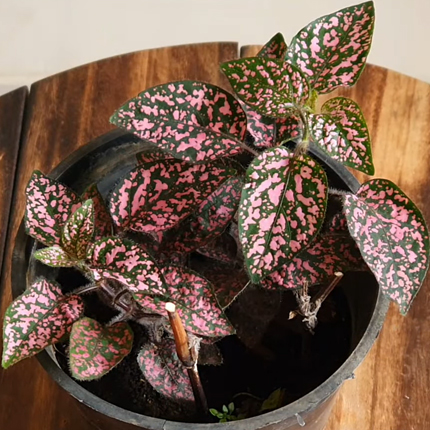The houseplant polka dot is an exotic guest of our window sills, which is distinguished by variegated leaves on long petioles. Due to its originality and unpretentiousness in care, the culture is very popular with gardeners. Even a beginner can grow a polka dot flower.
Features of polka dot
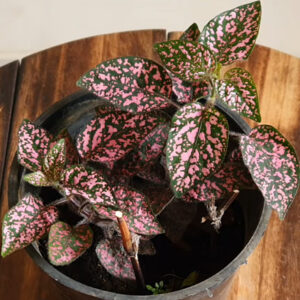
Polka dot is an evergreen representative of the flora that belongs to the Acanthus family. The natural habitat of the species is the territory of South Africa and Madagascar. The name of the plant consists of two words "under" and "house". The culture got its name thanks to the buds that hide under the bracts, as if in a house. Polka dot include low-growing branchy shrubs and herbaceous species. The leaves are heart-shaped, opposite each other, with simple or carved edges. The coloring of the leaf plates is very decorative: small blotches of various colors (red, ruby, pink) flaunt on a green background. Buds in the amount of 1-3 pieces grow in semi-umbellate inflorescences, they are covered with fused bracts.
Types of polka dot
There are many types of polka dot, which have different characteristics and require different types of care. Below we give examples of the most popular cultivated polka dot.
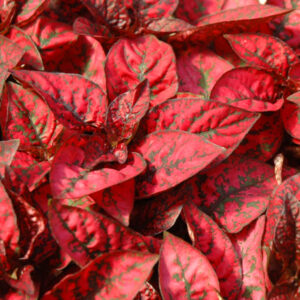
- Blood red polka dot. The plant prefers shady areas in the tropical jungle on the island of Madagascar. This is a branched lush shrub that can grow up to 50 centimeters in height. Leaf plates are entire, ovoid in shape, 4 centimeters wide and 6-8 centimeters long. The edging of the leaves is wavy, the surface is painted in rich green and dotted with red dots and purple veins.
- Leafy polka dot. This species is most often found in humid wooded areas also in Madagascar. At first glance, the leafy spikelet can be confused with the blood-red polka dot, but its leaves have a more purple hue. The buds are medium-sized, grow singly, painted in a pale purple color.
- Fiery polka dot. This variety is very fond of landscape designers. The fiery polka dot is a tall bush (about 80 cm) with narrow and large leaves, which are dotted with small spots. The surface of peduncles and leaves is fluffy.
- Polka dot Splash Select. It is an evergreen perennial with showy spotty leaf blades. Under normal growing conditions, the bush is able to reach a height of only about 40 centimeters, its leaves are ellipsoid, with smooth edges. This species is not only decorative, but also undemanding in care. It is customary to plant a crop for seedlings with the advent of spring, then the sprouts dive and transplant into permanent pots.
- Polka dot Confetti. Another variety of polka dot that is in demand among flower growers, which is represented by several varieties with leaves of different colors. Most often you can find white, purple-blue and burgundy crops.
- Polka dot Spray. A highly decorative variety, on the leaves of which there are multi-colored spots, and a contrasting edging, and stripes. The plant is undersized, no more than 25 centimeters in height, unpretentious care. The only mandatory requirement is regular pruning.
- Polka dot Mix. This plant, like some types of arrowroot , is distinguished by dark green leaf plates with sophisticated patterns. The culture is extremely warm and moisture-loving, so it is best to put a container with a flower on the southern windowsill and water it generously.
Reproduction of polka dot
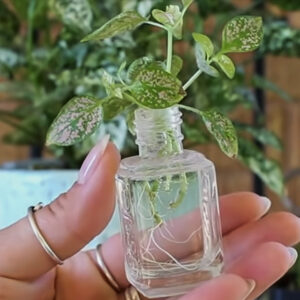
Polka dot can be propagated vegetatively (by cuttings) or by seeds. Seeds are sown in March. To do this, evenly distribute them over the surface of the substrate and slightly deepen. Cover the containers with polyethylene or glass from above and place them in a room with a temperature of 15-18 ° C. Do not forget to periodically remove the screen for ventilation. Sprouts will appear within a week. When the polka dot reaches the age of three months, it will already look like an adult specimen. Propagation by cuttings can be resorted to in any season of the year. To do this, carefully cut off the cuttings (their length is not important, the main thing is that each has a pair of growth points). Branches can be rooted in water or soil. The container with the seedling must be covered with a bag to create the effect of a greenhouse and cleaned in a warm place. Rooting cuttings will not take long.
Polka dot Care
As mentioned above, caring for polka dot, like caring for calathea , is simple. The flower is quite unpretentious and tenacious.
Lighting
Polka dot loves good but diffused lighting. The flower's need for light does not disappear even in winter, therefore, during this period of the year, gardeners strongly recommend that the plant be illuminated with ordinary lamps. This is a prerequisite, because otherwise the spectacular spotting will slowly disappear.
Temperature regime
A tropical flower should be kept warm. So, in spring and summer, try to keep the temperature in the room at 23-25 ° C, and in autumn and winter - 17-18 ° C. In addition, polka dot react negatively to sudden temperature fluctuations and drafts.
Watering
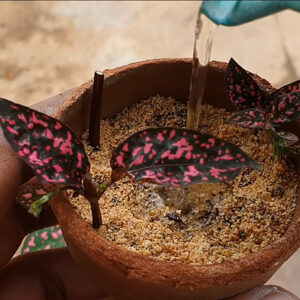
Moisture-loving culture should be watered generously, especially in the warm seasons of the year. Start watering as soon as the top of the soil dries out. It is forbidden to allow the soil clod to dry completely, as this is fraught with the discharge of all foliage. With the advent of cold weather, the volume and frequency of watering is gradually reduced. In winter, it is customary to water the bush two days after the top layer of the substrate dries.
Air humidity
Polka dot loves high humidity no less than abundant watering. Moisten the leaves regularly from a spray bottle with soft settled water. In addition, you can put wet pebbles in the pan or pour water, as long as the bottom of the container is not immersed in liquid.
Fertilizer
The culture is fertilized from March to October once every 3 or 4 weeks. Polka dot need to be fed with an increased dose of potassium. This element makes the foliage even brighter and more colorful.
pruning
Since polka dot is an ornamental houseplant, its appearance must be regularly looked after. So, pinching is the key to the splendor and neat shape of the bush. Thanks to this procedure, the stems will not stretch so much, but, on the contrary, will begin to branch in the right direction.
Transfer
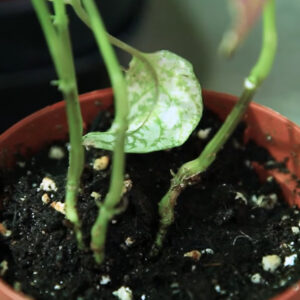
It is customary to transplant a polka dot bush once a year in spring. Gardeners recommend updating the bushes at least once every three years, then their decorative effect will be maintained at the right level. Before transplanting, prepare the soil mixture. To do this, mix humus soil, garden soil, river sand and peat in a ratio of 1:2:1:1. It is desirable that the soil be neutral or slightly acidic. The flower also needs drainage.
Pests and diseases
Polka dot have very strong immunity. Plants can only get sick due to improper care. With excessive watering, rotting of the roots will begin, yellowing, and then falling of the leaf plates. And, if, on the contrary, the bush does not have enough moisture, then the roots will begin to shrink and die, and later the leaves will fall. In low light, the leaves will become thinner and shrink, which will also affect the showiness of the view. Insect pests most often settle on polka dot by roaming from neighboring diseased flowers, so quarantine them in time.
